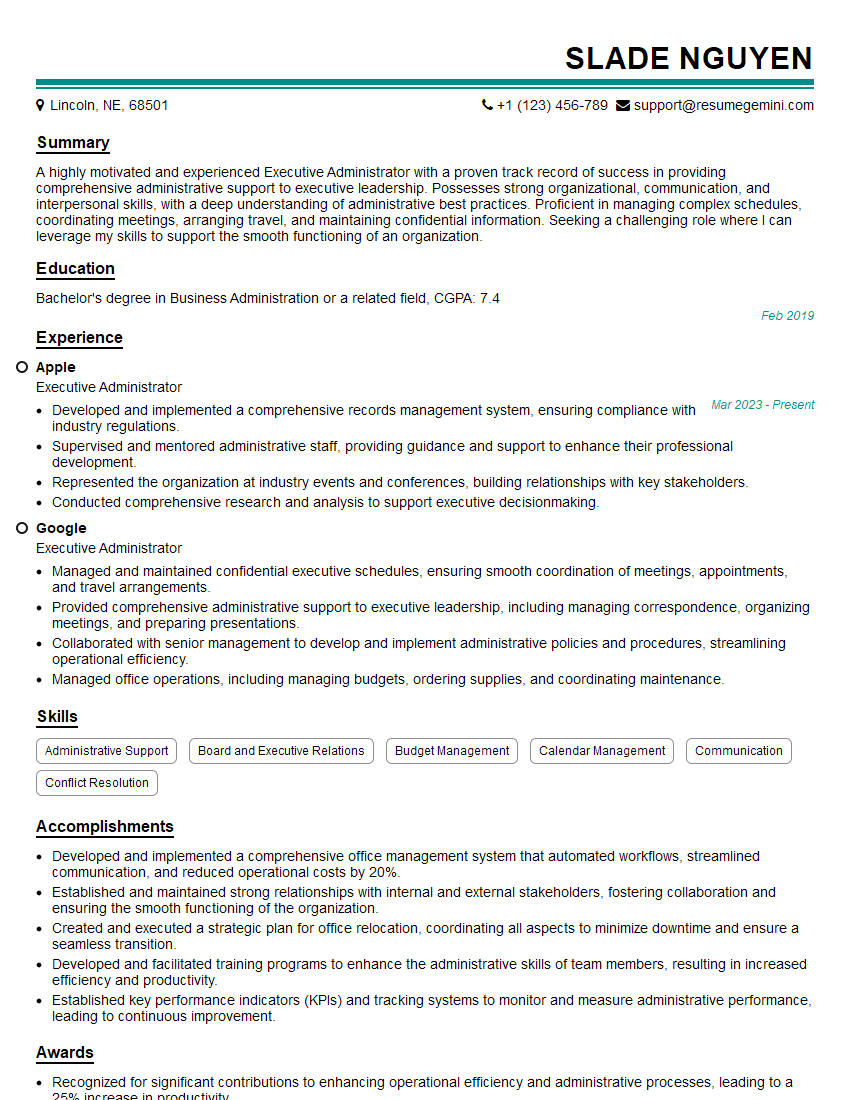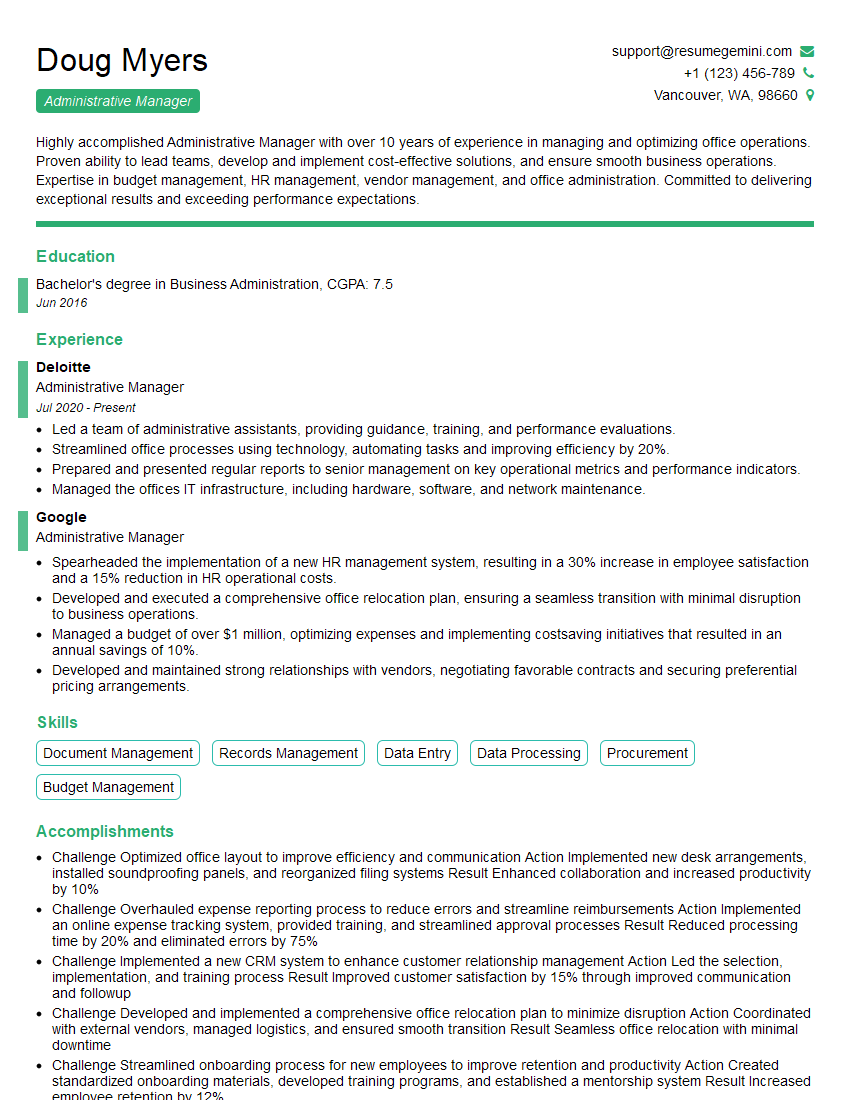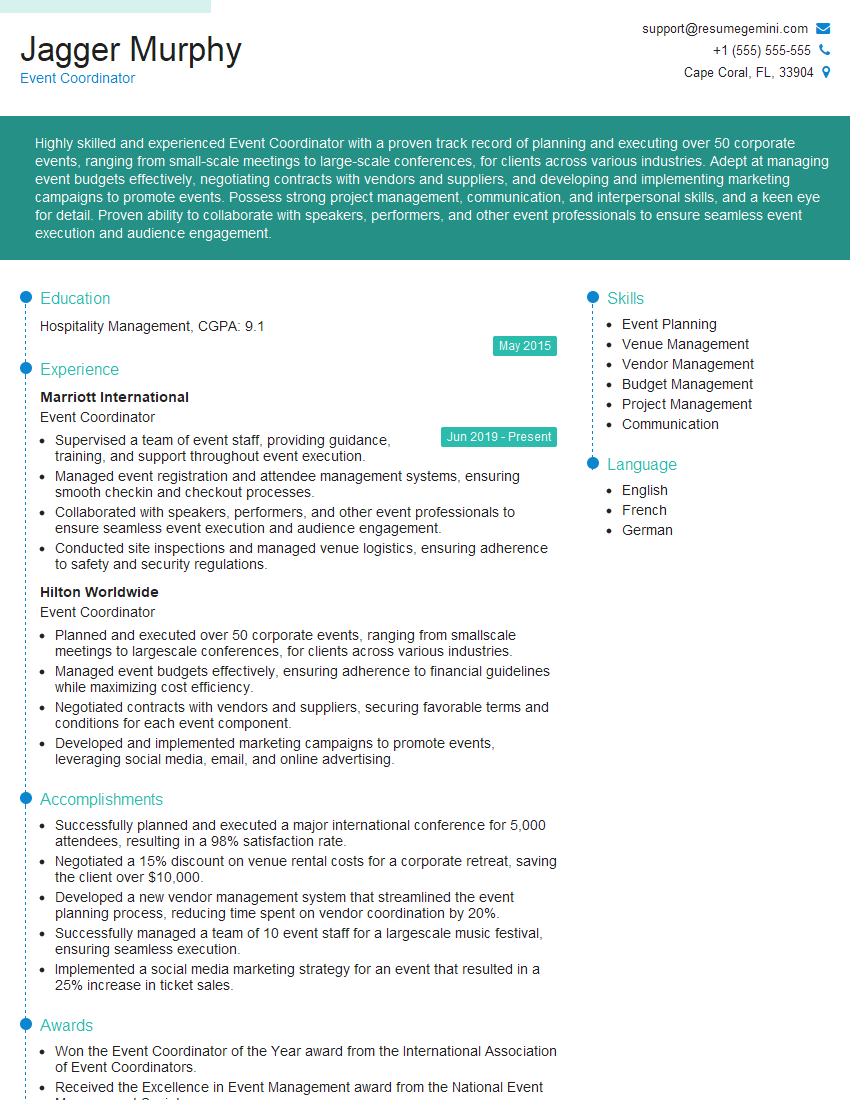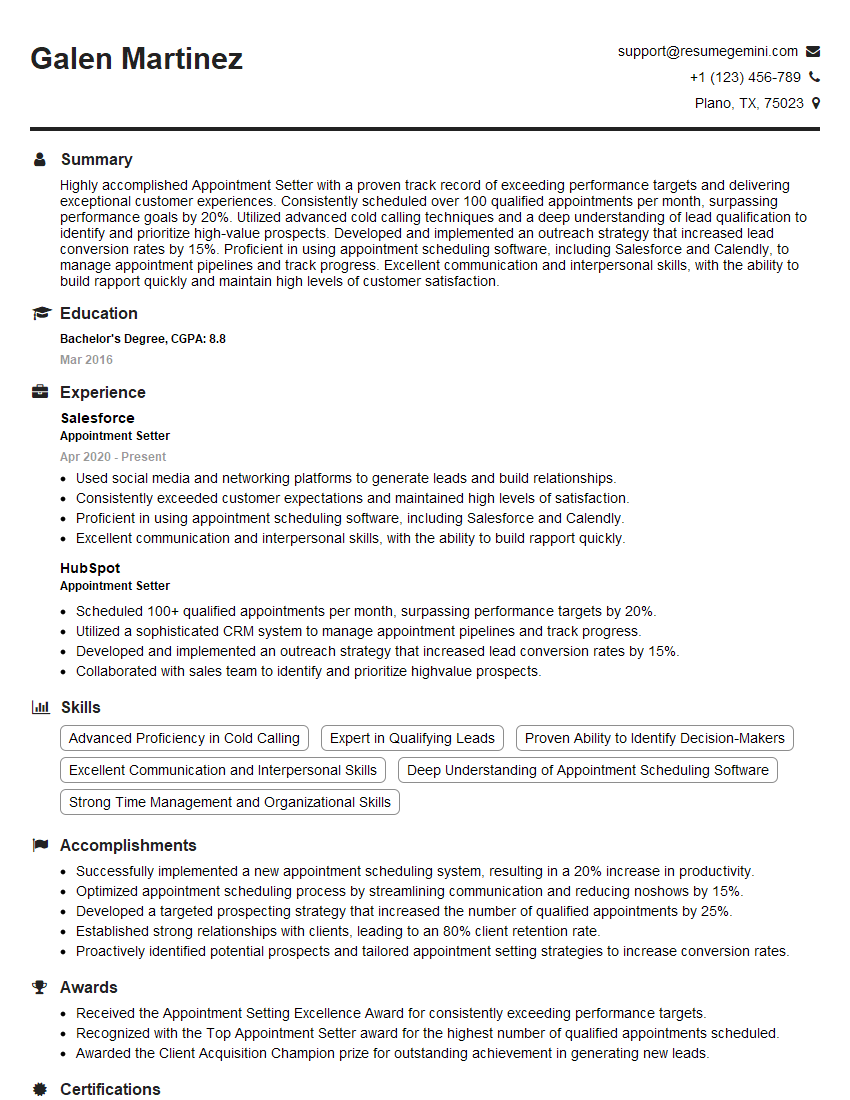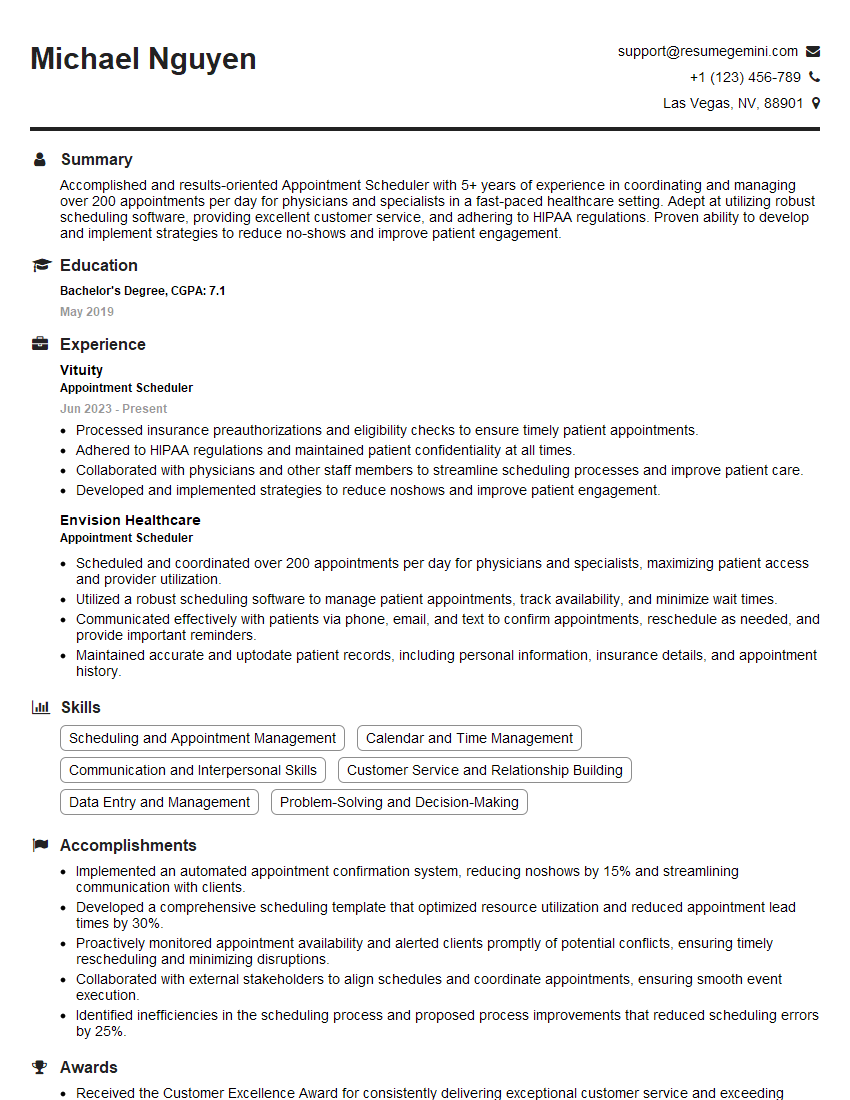Interviews are opportunities to demonstrate your expertise, and this guide is here to help you shine. Explore the essential Scheduling and Managing Calendars interview questions that employers frequently ask, paired with strategies for crafting responses that set you apart from the competition.
Questions Asked in Scheduling and Managing Calendars Interview
Q 1. Explain your experience with different scheduling software (e.g., Outlook, Google Calendar, Calendly).
My experience with scheduling software spans a variety of platforms, including Outlook, Google Calendar, and Calendly. Each offers unique strengths. Outlook, for example, excels in its integration with the Microsoft Office suite, making it ideal for managing tasks and emails alongside appointments. I’ve used its features extensively for setting up recurring meetings, managing shared calendars for team projects, and utilizing its robust reminder system. Google Calendar, on the other hand, stands out for its accessibility across various devices and its seamless collaboration features. I’ve leveraged its color-coding and notification options to manage complex schedules involving multiple clients and projects. Calendly, with its automated scheduling capabilities, has proved invaluable in streamlining the appointment-booking process, especially for client consultations, significantly reducing back-and-forth email exchanges. I understand the nuances of each platform and can adapt my approach based on the specific requirements of a project or team.
Q 2. How do you prioritize conflicting appointments or meetings?
Prioritizing conflicting appointments requires a systematic approach. I first identify the urgency and importance of each meeting. I use a prioritization matrix, often visualizing it as a simple 2×2 grid: Urgent/Important, Important/Not Urgent, Urgent/Not Important, and Not Urgent/Not Important. Meetings categorized as Urgent/Important naturally take precedence. For instance, a last-minute client meeting demanding immediate attention would supersede a less critical internal brainstorming session. Next, I evaluate the potential consequences of rescheduling or postponing each appointment, considering the impact on various stakeholders. Finally, I communicate proactively with all involved parties, explaining the situation and suggesting alternative time slots. Transparent and timely communication is key to minimizing disruption and maintaining positive relationships.
Q 3. Describe your method for managing multiple calendars simultaneously.
Managing multiple calendars simultaneously is a core competency. I primarily rely on color-coding within Google Calendar, assigning distinct colors to different aspects of my schedule – personal appointments, work projects, client meetings, and so on. This visual distinction allows me to quickly grasp the overall picture. I also utilize calendar views that allow me to see multiple calendars simultaneously, like the ‘Day’ or ‘Week’ view. In situations requiring even greater organization, I use a calendar management tool that aggregates information from various sources into a centralized dashboard. This provides a holistic overview and simplifies conflict resolution. This structured approach reduces the chance of overlooking commitments and ensures efficient time management.
Q 4. How do you handle last-minute scheduling requests?
Handling last-minute scheduling requests requires flexibility and efficiency. My response depends on several factors: the urgency of the request, my existing commitments, and the importance of the new request. I always check my calendar first to determine available slots. If a suitable time slot exists, I confirm the appointment immediately and update my calendar accordingly. If no immediate availability exists, I propose alternative times and explain the constraints. It’s crucial to respond promptly, even if it’s to say that I’m unable to accommodate the request at that moment. Honesty and clear communication are crucial in these situations. I always strive to maintain a balance between accommodating requests and protecting my own time and schedule.
Q 5. What strategies do you use to prevent double-booking?
Preventing double-booking relies heavily on proactive measures. Firstly, I meticulously update my calendar immediately after scheduling any appointment, ensuring accuracy and consistency. I use calendar alerts and reminders to avoid conflicts and maintain an up-to-date schedule. Secondly, I prefer using scheduling tools that offer double-booking prevention features, flagging any potential conflicts. For shared calendars, clear communication and collaboration within the team are vital. For example, when managing a shared team calendar, we might establish a rule where team members request bookings in advance to allow for thorough checking for potential scheduling conflicts before confirming the appointment. Regularly reviewing and verifying the calendar prevents minor oversights from turning into major scheduling errors.
Q 6. How do you ensure all appointments are accurately recorded and updated?
Ensuring accurate appointment records involves several key steps. I prioritize detailed entries, including the date, time, subject, location, participants, and any relevant notes. I use the calendar’s built-in features for adding attachments, such as meeting agendas or relevant documents. Regularly reviewing and updating the calendar for accuracy is crucial. I make a point of comparing my calendar entries against other sources such as confirmation emails or meeting invitations to double-check details. This rigorous approach minimizes inaccuracies and ensures consistency across all my scheduling tools and documentation. Backups are also important for ensuring data is not lost.
Q 7. Describe your experience with setting up recurring appointments.
Setting up recurring appointments is a time-saver. I leverage the built-in recurring appointment features of my chosen calendar software. For example, in Google Calendar or Outlook, I can easily create a recurring meeting by specifying the start time, end time, frequency (daily, weekly, monthly, etc.), and the duration. I carefully consider the frequency and duration of the recurring event, ensuring it aligns with the specific needs of the project or task. I’ve used this extensively for managing weekly team meetings, monthly progress reviews, and regular client check-ins. The ability to easily adjust or cancel recurring events as needed enhances the flexibility and efficiency of the process.
Q 8. How do you manage time zone differences when scheduling meetings?
Managing time zone differences in scheduling is crucial for seamless collaboration across geographical boundaries. My approach involves utilizing tools that automatically adjust for time zones and clearly displaying the time in each participant’s local time. For instance, when scheduling a meeting using tools like Google Calendar or Outlook, I always ensure that the ‘Add Guests’ function is used. This allows the system to automatically display the meeting time in the correct time zone for each attendee. I also explicitly mention the time zones in the meeting invitation, for clarity. Imagine scheduling a meeting with a team in London and another in New York – clearly stating ’10 AM GMT / 5 AM EST’ prevents confusion. If using a less sophisticated tool, I often use a time zone converter website to manually calculate the appropriate times for each participant and include this information in the meeting request.
Q 9. How do you handle cancellations and rescheduling?
Cancellations and rescheduling are handled promptly and professionally. First, I immediately notify all attendees of the cancellation, clearly stating the reason and apologizing for any inconvenience. Then, I suggest alternative times, proposing a few options to accommodate various schedules. I use the same scheduling tools as the initial invitation (Google Calendar, Outlook, etc.) to quickly send out updated invitations. If the rescheduling involves significant changes, I might send a follow-up email confirming the new time and any relevant details. For instance, if a client cancels a 2 PM meeting due to a conflicting appointment, I’d immediately send an email stating the cancellation, offer three alternative times within the following week, and then send an updated calendar invitation upon agreement. Transparency and efficiency are key to mitigating disruption.
Q 10. What are your preferred methods for communicating scheduling updates?
My preferred methods for communicating scheduling updates prioritize clarity and efficiency. For minor updates, like a slight time adjustment, I leverage calendar notification features inherent in tools like Google Calendar or Outlook. These built-in updates automatically reach attendees. However, for significant changes, like cancellations or major reschedulings, I prefer a combination of email and calendar updates. This ensures that everyone gets the information, and the email provides context and prevents important details from being missed in a quick calendar update. I also utilize the calendar’s comment function when appropriate, for quick notes or answers to attendee questions.
Q 11. How do you maintain the confidentiality of scheduling information?
Maintaining confidentiality of scheduling information is paramount. I only share scheduling details with those directly involved in the meeting or event. I use calendar features that restrict access to sensitive information, like setting calendar privacy settings to ‘Private’ in Outlook or Google Calendar. This limits visibility to only the invited attendees. I never share meeting details over insecure channels, and ensure that any sensitive information discussed during the meeting is handled according to the established privacy policies. For example, if I’m scheduling a meeting discussing confidential client data, I’d only invite those with a need to know and ensure the calendar event is set to private and password protected if necessary.
Q 12. How do you optimize calendar usage for maximum efficiency?
Optimizing calendar usage for maximum efficiency involves several strategies. I utilize color-coding to visually distinguish different types of appointments (e.g., client meetings, internal projects, personal appointments). I strategically block out time for focused work, preventing meeting overload. I also leverage calendar reminders to ensure I’m prepared and on time for every event. Furthermore, I regularly review and clean my calendar, deleting outdated events and consolidating similar appointments where possible. Finally, I experiment with different calendar views to see which best fits my workflow, moving between daily, weekly, and monthly views as needed. Think of it like decluttering your physical workspace – a well-organized calendar frees up mental space for more important tasks.
Q 13. Describe your experience using scheduling features in collaboration tools (e.g., Slack, Microsoft Teams).
My experience with scheduling features in collaboration tools like Slack and Microsoft Teams has been largely positive. Slack’s integration with other calendars allows for easy scheduling and notification, and the ability to directly coordinate with team members within the platform streamlines the process. Microsoft Teams offers similar functionality, with the benefit of its deep integration into the broader Microsoft 365 suite. The ability to directly schedule meetings from within these platforms, with direct calendar synchronization, eliminates the need for back-and-forth emails. Both platforms have greatly reduced the administrative burden associated with scheduling, helping to keep projects on track.
Q 14. What are some common scheduling challenges you’ve faced and how did you overcome them?
One common challenge is coordinating schedules across multiple time zones with differing working hours. I’ve overcome this by using time zone converter tools and clearly communicating proposed meeting times in all relevant time zones. Another challenge is managing conflicting appointments. To address this, I utilize the calendar’s ‘busy’ status feature proactively and clearly communicate availability to avoid double-booking. A third recurring issue is last-minute cancellations or reschedulings. My solution is to develop strong communication habits, ensuring prompt notifications and offering flexible alternative times to minimize disruption. Proactive communication and robust scheduling tools are key to overcoming these challenges.
Q 15. How familiar are you with different calendar views (e.g., day, week, month)?
Different calendar views are crucial for effective time management. I’m highly proficient with various views, understanding their strengths and weaknesses for different tasks. The day view is ideal for detailed scheduling and managing appointments hour-by-hour. The week view provides a broader perspective, allowing for an overview of the week’s commitments and identifying potential conflicts. The month view offers a high-level summary, perfect for long-term planning and visualizing project deadlines. I also have experience with other views like the agenda view (listing events chronologically) and the year view (for annual planning). Choosing the right view is dependent on the task at hand. For example, a busy sales professional might favor a week view for managing client meetings, while a project manager might use a month view to track milestones.
Career Expert Tips:
- Ace those interviews! Prepare effectively by reviewing the Top 50 Most Common Interview Questions on ResumeGemini.
- Navigate your job search with confidence! Explore a wide range of Career Tips on ResumeGemini. Learn about common challenges and recommendations to overcome them.
- Craft the perfect resume! Master the Art of Resume Writing with ResumeGemini’s guide. Showcase your unique qualifications and achievements effectively.
- Don’t miss out on holiday savings! Build your dream resume with ResumeGemini’s ATS optimized templates.
Q 16. How do you deal with individuals who frequently change their appointments?
Frequent appointment changes can be disruptive, so I approach them proactively. First, I establish clear communication channels. I encourage individuals to notify me as soon as possible about any changes, ideally with sufficient advance notice. I also leverage features like calendar notifications and reminders to myself to stay updated. If changes are constant and negatively impacting others, I initiate a discussion to understand the root cause. Is it a lack of planning, an unpredictable work schedule, or something else? This helps find solutions, such as implementing a buffer in the schedule or exploring alternative scheduling methods. In some cases, I might suggest using a scheduling tool that allows for easier rescheduling and notification to all parties involved.
Q 17. What are your strategies for proactive scheduling?
Proactive scheduling involves anticipating needs and planning ahead to avoid conflicts and maximize efficiency. My strategies include:
- Regular review: I routinely review upcoming schedules and identify potential issues or areas for improvement.
- Buffer time: I incorporate buffer time between appointments to account for unexpected delays or meetings running over.
- Prioritization: I prioritize tasks based on urgency and importance, scheduling the most critical items first.
- Theme days: I sometimes designate specific days for certain types of tasks (e.g., Mondays for meetings, Tuesdays for focused work) to improve concentration and workflow.
- Batching similar tasks: Grouping similar tasks (e.g., responding to emails, making phone calls) together improves efficiency and reduces context switching.
Q 18. Explain your experience with setting up and managing meeting rooms or resources.
I have extensive experience managing meeting rooms and resources using various software and systems. This involves setting up booking systems, assigning resources based on availability and capacity, and tracking usage. I’m familiar with software such as Outlook Room Scheduling and various third-party booking platforms. My approach includes:
- Clear booking policies: Establishing clear guidelines for booking rooms and resources, including cancellation policies.
- Real-time availability: Using software that displays real-time availability of resources to prevent double bookings.
- Automated notifications: Setting up automated reminders to both the booker and the administrator.
- Conflict resolution: Handling booking conflicts efficiently and fairly, possibly by finding alternative rooms or times.
Q 19. How do you handle requests outside of normal business hours?
Requests outside of normal business hours require a different approach. I generally have a process for handling urgent requests, perhaps through an on-call system or designated contact information for after-hours emergencies. For non-urgent requests, I typically acknowledge receipt and indicate a response time within the next business day. The key is clear communication and managing expectations. A simple automated response confirming receipt and indicating when a response will be received can significantly improve client experience.
Q 20. Describe a time you had to manage a complex scheduling situation. How did you solve it?
In a previous role, we had a major conference to organize with numerous speakers, sessions, and attendees. The scheduling was incredibly complex due to speaker availability, conflicting session times, and venue limitations. My solution involved using project management software to track all the constraints. I created a detailed spreadsheet outlining all sessions, speaker preferences, and room capacities. Then, I used a trial-and-error approach combined with a visual scheduling tool to optimize the schedule and minimize conflicts. This iterative process ensured all speakers could present, sessions were well-spaced, and the venue capacities were respected. This involved several late nights and revisions but successfully resulted in a well-organized and successful conference.
Q 21. How do you ensure accuracy when inputting appointments?
Accuracy is paramount when inputting appointments. I use a multi-step process to ensure accuracy:
- Double-checking information: I always double-check the date, time, attendees, and location before saving an appointment.
- Using calendar features: I leverage the calendar’s features for reminders and notifications to prevent missed appointments.
- Confirmation emails or messages: I often send confirmation emails or messages to attendees to confirm the details and allow for corrections.
- Standardization: I use consistent formatting for all events to minimize errors and improve readability.
Q 22. How do you use technology to streamline your scheduling process?
Technology is indispensable for streamlining scheduling. I primarily rely on cloud-based calendar applications like Google Calendar or Microsoft Outlook, leveraging their features for maximum efficiency. This includes:
- Automated Scheduling: I utilize appointment scheduling tools that integrate with my calendar, allowing clients or colleagues to book time slots directly, eliminating back-and-forth emails. This saves considerable time and ensures accurate booking.
- Calendar Sharing and Permissions: I strategically share calendars with relevant stakeholders, granting appropriate access levels (view-only, edit, etc.) to maintain transparency and control. For example, my team might have ‘edit’ access to our shared project calendar, while clients have ‘view-only’ access to appointments with them.
- Reminders and Notifications: I set up automated reminders for myself and attendees, ensuring that no one misses appointments or deadlines. These can be customized for frequency and delivery method (email, SMS, in-app notification).
- Integration with other tools: My calendar integrates with project management software (like Asana or Trello) and CRM systems, providing a single source of truth for all scheduling-related information. This allows me to easily see all my tasks and appointments in one place.
For example, I recently implemented a scheduling tool that reduced appointment booking time by 50%, allowing me to focus more on tasks requiring creative problem-solving.
Q 23. What methods do you use to ensure important deadlines are met?
Meeting deadlines requires a proactive approach that combines careful planning with effective monitoring and adjustments. My methods include:
- Project Breakdown and Task Assignment: I break down large projects into smaller, manageable tasks with clearly defined deadlines. Each task is assigned a responsible party with accountability built into the system.
- Prioritization and Time Blocking: I prioritize tasks based on urgency and importance using methods like Eisenhower Matrix (urgent/important). Time blocking ensures dedicated time slots for critical tasks, preventing them from being overtaken by less important items.
- Regular Progress Monitoring: I schedule regular check-ins (daily or weekly depending on project complexity) to track progress and identify potential roadblocks early. This allows for proactive adjustments to keep projects on schedule.
- Contingency Planning: I always build buffer time into schedules to account for unforeseen delays or issues. This minimizes the impact of unexpected events on the project timeline.
- Utilizing Calendar Features: My calendar serves as a visual reminder of approaching deadlines, with color-coded flags or categories for high-priority tasks.
Think of it like a meticulously planned journey – you wouldn’t attempt a cross-country drive without a map and regular fuel stops, right? Similarly, meticulous planning and regular monitoring are key to reaching project goals on time.
Q 24. How do you communicate scheduling changes effectively to multiple stakeholders?
Effective communication of scheduling changes is vital for avoiding confusion and maintaining team cohesion. I utilize a multi-pronged approach:
- Clear and Concise Notifications: When changes occur, I send out clear and concise notifications via email or the chosen calendar application. The message always includes the nature of the change, the reason for the change, and the updated details.
- Multiple Communication Channels: Depending on the urgency and the audience, I might use email, calendar updates, instant messaging (Slack, Teams), or even a quick phone call. Redundancy ensures everyone receives the message.
- Automated Notifications: Calendar applications often offer automated notifications. I leverage this functionality to ensure timely dissemination of scheduling updates. The notifications can be customized to target specific individuals or groups.
- Centralized Communication: For large-scale changes, I may utilize a company-wide announcement or a meeting to ensure everyone is informed and understands the reason behind the change.
- Follow-Up: After sending out notifications, I often follow up to confirm receipt and address any questions or concerns.
For example, recently needing to reschedule a major team meeting, I used both email and a company-wide announcement, then followed up with team leads to ensure everyone was on board.
Q 25. What are your strategies for preventing scheduling conflicts among team members?
Preventing scheduling conflicts requires a combination of proactive planning and communication. My strategies involve:
- Shared Calendars: All team members share their calendars, providing a centralized view of everyone’s availability. This allows easy identification of potential conflicts before they arise.
- Booking Systems with Conflict Resolution: Many scheduling systems automatically prevent double-bookings, alerting users to conflicts as they attempt to schedule events. I actively utilize this functionality.
- Team Meetings for Coordination: Regular team meetings provide a forum for discussing upcoming events and coordinating schedules, avoiding spontaneous clashes.
- Clear Communication Protocols: Establish clear guidelines for requesting time off, booking meetings, and reporting absences, reducing ambiguity and the chance of conflicts.
- Utilizing Scheduling Software with Resource Management: If managing multiple resources (meeting rooms, equipment), specialized scheduling software can help optimize allocation, preventing conflicts over shared assets.
Think of it like orchestrating a symphony – each musician needs to know their part and the timing perfectly to avoid a cacophony. Similarly, clear communication and shared awareness are vital for seamless scheduling within a team.
Q 26. How do you stay organized when dealing with a high volume of scheduling requests?
Managing a high volume of scheduling requests requires a structured and organized approach. My strategies include:
- Categorization and Prioritization: I categorize incoming requests by urgency and importance, allowing me to focus on the most pressing matters first. This utilizes a system similar to the Eisenhower Matrix.
- Batch Processing: I dedicate specific blocks of time to address scheduling requests, maximizing efficiency. This avoids constant interruptions and allows for focused attention.
- Automated Tools and Templates: Using automated response systems and pre-designed email templates streamlines responses to common scheduling inquiries, reducing manual effort.
- Delegation (where applicable): For certain tasks or less urgent requests, I delegate responsibility to other team members with appropriate training and authority.
- Regular Calendar Review and Cleanup: I schedule regular time to review my calendar, remove outdated entries, and consolidate overlapping events, maintaining clarity and minimizing clutter.
Imagine a well-organized inbox – you wouldn’t let emails pile up unanswered, right? Similarly, consistent review and management of scheduling requests is key to staying on top of a high volume.
Q 27. How do you adapt your scheduling strategies based on the needs of different individuals or teams?
Adapting scheduling strategies to individual and team needs is crucial for effective management. This involves understanding individual working styles and team dynamics:
- Flexible Scheduling: Some individuals thrive on structured schedules, while others prefer more flexibility. I tailor scheduling approaches to meet individual preferences wherever possible, within project constraints.
- Team-Specific Calendars and Communication: Different teams might have unique scheduling needs. For example, a project team might need frequent short meetings, whereas a sales team might have longer, less frequent meetings. I establish team-specific calendars and communication channels to meet these requirements.
- Understanding Time Zones: When working with international teams, I carefully consider time zones to ensure meeting times are convenient for all participants. I use time zone converters and scheduling tools to accommodate global collaboration.
- Considering Individual Preferences: I actively seek input from individuals about their preferred working styles and meeting preferences. This ensures buy-in and maximizes efficiency.
- Regular Feedback and Adjustment: I regularly solicit feedback from individuals and teams on the effectiveness of the current scheduling practices, allowing for continuous improvement and adaptation.
Like tailoring a suit – it needs to fit the individual perfectly for optimal comfort and function. Similarly, scheduling must adapt to the unique needs of individuals and teams for maximum effectiveness.
Q 28. Describe your experience working with different scheduling systems and integrating them.
I have extensive experience with various scheduling systems, including Google Calendar, Microsoft Outlook, scheduling plugins for project management tools (like Asana and Trello), and dedicated appointment scheduling software. My experience with integrating these systems involves:
- API Integration: I have experience utilizing APIs to seamlessly connect different scheduling systems, allowing data to flow between them automatically. This minimizes manual data entry and improves accuracy.
- Data Migration: I have managed data migration between different scheduling systems, ensuring data integrity and minimal disruption during transitions.
- Customization and Configuration: I am proficient in configuring and customizing scheduling systems to meet specific organizational requirements, optimizing workflows and processes.
- Troubleshooting and Problem Solving: I have effectively troubleshooted and resolved integration issues between different systems, ensuring seamless functionality.
- Training and Support: I have provided training to colleagues on utilizing different scheduling systems and their integration features, ensuring effective adoption and minimizing confusion.
For example, I recently integrated our company’s CRM with our scheduling software, which automated the process of booking client meetings, reducing administrative workload by 40% and enhancing efficiency.
Key Topics to Learn for Scheduling and Managing Calendars Interview
- Calendar Systems & Software Proficiency: Understanding various calendar platforms (Google Calendar, Outlook Calendar, etc.), their features, and efficient navigation. Practical application: Demonstrate your ability to quickly master a new calendar system.
- Time Management & Prioritization: Mastering techniques for efficient time allocation, appointment scheduling, and managing conflicting appointments. Practical application: Describe a scenario where you successfully managed competing deadlines and priorities using a calendar.
- Meeting Coordination & Scheduling Best Practices: Optimizing meeting schedules, considering time zones, and utilizing features like recurring events and reminders. Practical application: Explain your approach to scheduling meetings for multiple participants across different time zones.
- Resource Allocation & Conflict Resolution: Allocating resources (meeting rooms, equipment) effectively and resolving scheduling conflicts proactively. Practical application: Describe a situation where you resolved a scheduling conflict and the strategies you employed.
- Data Management & Reporting: Utilizing calendar data for reporting purposes, identifying trends, and improving scheduling efficiency. Practical application: Explain how you would use calendar data to analyze meeting effectiveness or identify scheduling bottlenecks.
- Advanced Calendar Features: Exploring and leveraging advanced features such as calendar integrations, automated scheduling, and notification systems. Practical application: Discuss your experience using any advanced calendar features to streamline workflows.
Next Steps
Mastering scheduling and calendar management is crucial for success in today’s fast-paced work environments. It showcases your organizational skills, attention to detail, and ability to proactively manage your time and others’. An ATS-friendly resume is essential for maximizing your job prospects. To build a compelling and effective resume that highlights these skills, we encourage you to use ResumeGemini, a trusted resource for creating professional resumes. Examples of resumes tailored to Scheduling and Managing Calendars are available to help you craft your perfect application.
Explore more articles
Users Rating of Our Blogs
Share Your Experience
We value your feedback! Please rate our content and share your thoughts (optional).
What Readers Say About Our Blog
Hi, I’m Jay, we have a few potential clients that are interested in your services, thought you might be a good fit. I’d love to talk about the details, when do you have time to talk?
Best,
Jay
Founder | CEO
